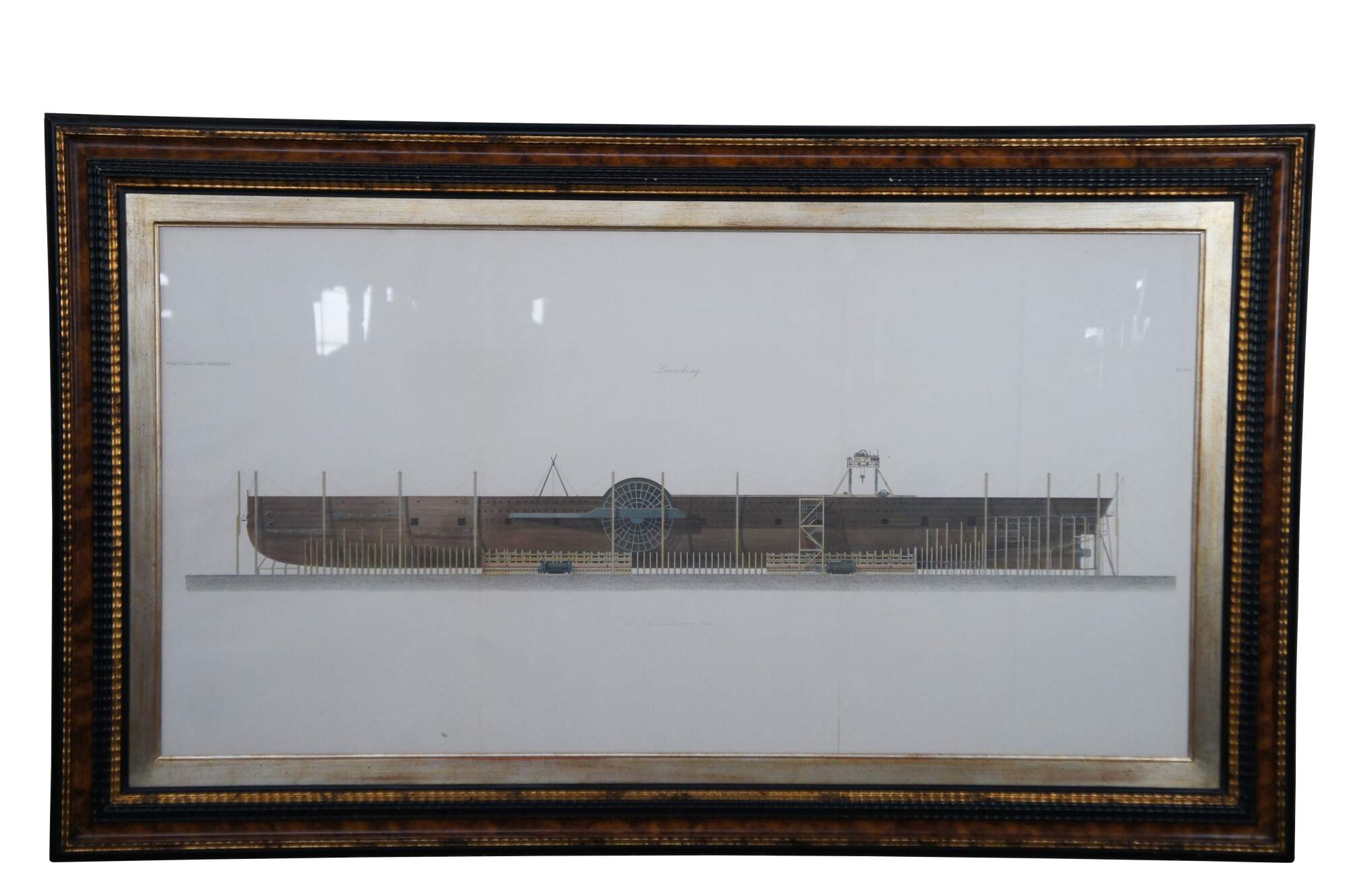
Shipping:
Free Shipping Included
Delivery:
Estimated 2-15 Business Days
Payments:
Credit Card, Check, Cash, PayPal, Apple Pay, Venmo
Returns:
30 Days 100% Money Back Guarantee, Buyer Pays Return Shipping
Description
A very large antique 1864 lithograph print by Day & Son of London England. Practical Ship Building - Launching a Paddle Boat; Screw Gun Boat; and Paddle-Wheel Gun Boat
engraving, published 1864, plate 105.
Day & Son - Lithographers to the Queen
The firm of William Day, later Day & Son, has been described as one of the largest and most prominent lithographic firms of the second third of the nineteenth century. Company documents record William Day's business starting in 1823 although the first known lithograph was produced the following year. By 1829 the firm had moved from 59 Great Queen Street to 17 Gate Street.
From the early thirties the company was often referred to as Day & Haghe. This was due to the popularity of the work of Louis Haghe a Belgian draughtsman and water colourist who worked for the company until 1852 when he left to focus on painting.
The firm was granted the status of 'Lithographers to Queen Victoria and to the Queen Dowager, Queen Adelaide' in 1837 although they were not the only lithographers to be awarded the Royal Warrant. William Day Senior died in 1845 leaving the business in the hands of his son William Day Junior. The company now became known as Day & Son.
The 1850s started with a prize medal at the Great Exhibition for their display of lithography. In the mid fifties the premises in Gate Street were enlarged and the Prince of Wales and Prince Alfred visited (probably the completed works) in 1856.
In 1851, Day & Son was commissioned by Matthew Digby Wyatt, known for his work as an architect, to produce the book The Industrial Arts of the Nineteenth Century, an imposing imperial folio in two volumes which illustrates a selection of items from the Great Exhibition of 1851. There are 160 chromolithographed plates. Wyatt himself stated that he had used 'the best means of graphic representation available'.[30] Wyatt proudly drew attention to the previously unsurpassed scale and speed of production of the book. But what brought the entire project into being was the desire of Day & Son to demonstrate the potential of chromolithography. The firm was particularly associated with the process. However, as Wyatt himself explained, the proposal was not even formalized until after the Great Exhibition had opened. Such a grandiose production must have called into play a significant proportion of Day's resources, including skilled craftsmen and lithographers such as Francis Bedford, J.A. Vinter and Henry Rafter, as well as significant capital, and management. According to Wyatt, four or five of Day's staff were constantly engaged upon the business details of the operation alone.
In 1861 the firm printed a large run of bank notes for Lajos Kossuth, the famous Hungarian patriot and democratic. Kossuth was in exile from his homeland and this attempt at re-establishing a separate Hungarian currency lead to both him and Day & Son to be charged in the courts with having 'levied war upon the Emperor of Austria'. The affair ended with Day & Son delivering the notes to the Bank of England where they were duly burnt.
The firm now started to experience financial difficulties. Many stock auctions were held, the first, of engravings, taking place in 1865. That year Day & Son became a Limited Company. This not only meant that capital could be raised by the sale of shares but also that, in some cases, employees could be paid partly in shares in lieu of real wages. Another auction, this time of illustrated books, was held in 1866. Hodgson & Co. would continue to sell off Day & Son assets up until 1873.
Despite their other business worries by 1866 Day & Son Ltd, as well as Gate Street, had premises at 43 Piccadilly and at The German Gallery, New Bond Street. These were show rooms and exhibition spaces for the company's work. They also took on the well-known photographer Vernon Heath to manage the photographic department.
Since becoming a limited company, directorship was conditional on holding at least five hundred shares. Just two years after incorporation it was pointed out to William Day Junior that he no longer fulfilled this criterion. He refused to leave the board and after the resulting row he left the company and for a short time started business in Cockspur Street.
The firm now faced liquidation and was taken over by Vincent Brooks.
Condition
Good antique condition, wear and distressing from age, creasing to print, scuffing to frame, bug under glass.
Dimensions
36.5" x 61.5"